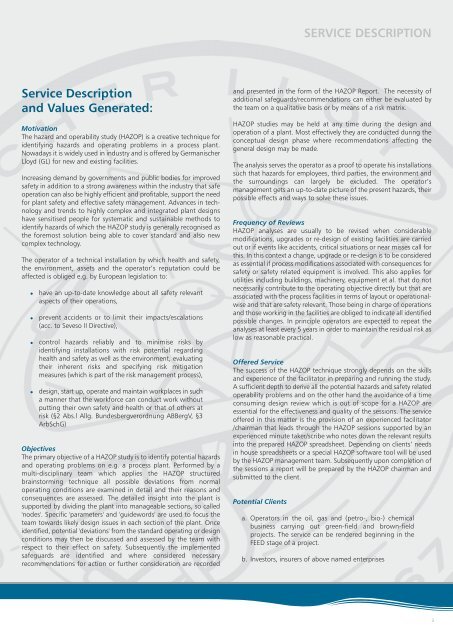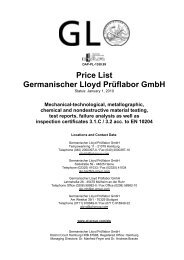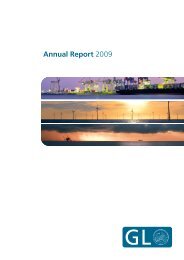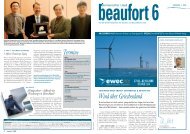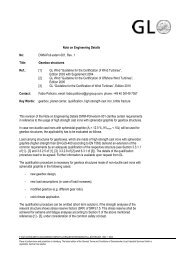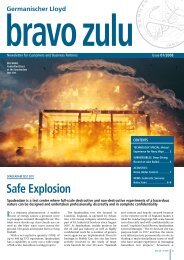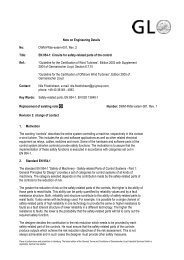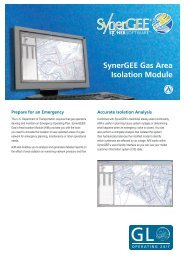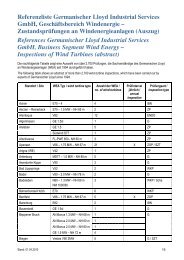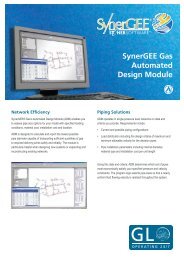Hazard Operability Studies (HAZOP) - GL Noble Denton
Hazard Operability Studies (HAZOP) - GL Noble Denton
Hazard Operability Studies (HAZOP) - GL Noble Denton
Create successful ePaper yourself
Turn your PDF publications into a flip-book with our unique Google optimized e-Paper software.
Service Description<br />
and Values Generated:<br />
Motivation<br />
The hazard and operability study (<strong>HAZOP</strong>) is a creative technique for<br />
identifying hazards and operating problems in a process plant.<br />
Nowadays it is widely used in industry and is offered by Germanischer<br />
Lloyd (<strong>GL</strong>) for new and existing facilities.<br />
Increasing demand by governments and public bodies for improved<br />
safety in addition to a strong awareness within the industry that safe<br />
operation can also be highly efficient and profitable, support the need<br />
for plant safety and effective safety management. Advances in technology<br />
and trends to highly complex and integrated plant designs<br />
have sensitised people for systematic and sustainable methods to<br />
identify hazards of which the <strong>HAZOP</strong> study is generally recognised as<br />
the foremost solution being able to cover standard and also new<br />
complex technology.<br />
The operator of a technical installation by which health and safety,<br />
the environment, assets and the operator’s reputation could be<br />
affected is obliged e.g. by European legislation to:<br />
have an up-to-date knowledge about all safety relevant<br />
aspects of their operations,<br />
prevent accidents or to limit their impacts/escalations<br />
(acc. to Seveso II Directive),<br />
control hazards reliably and to minimise risks by<br />
identifying installations with risk potential regarding<br />
health and safety as well as the environment, evaluating<br />
their inherent risks and specifying risk mitigation<br />
measures (which is part of the risk management process),<br />
design, start up, operate and maintain workplaces in such<br />
a manner that the workforce can conduct work without<br />
putting their own safety and health or that of others at<br />
risk (§2 Abs.l Allg. Bundesbergverordnung ABBergV, §3<br />
ArbSchG)<br />
Objectives<br />
The primary objective of a <strong>HAZOP</strong> study is to identify potential hazards<br />
and operating problems on e.g. a process plant. Performed by a<br />
multi-disciplinary team which applies the <strong>HAZOP</strong> structured<br />
brainstorming technique all possible deviations from normal<br />
operating conditions are examined in detail and their reasons and<br />
consequences are assessed. The detailed insight into the plant is<br />
supported by dividing the plant into manageable sections, so called<br />
'nodes'. Specific 'parameters' and 'guidewords' are used to focus the<br />
team towards likely design issues in each section of the plant. Once<br />
identified, potential 'deviations' from the standard operating or design<br />
conditions may then be discussed and assessed by the team with<br />
respect to their effect on safety. Subsequently the implemented<br />
safeguards are identified and where considered necessary<br />
recommendations for action or further consideration are recorded<br />
and presented in the form of the <strong>HAZOP</strong> Report. The necessity of<br />
additional safeguards/recommendations can either be evaluated by<br />
the team on a qualitative basis or by means of a risk matrix.<br />
<strong>HAZOP</strong> studies may be held at any time during the design and<br />
operation of a plant. Most effectively they are conducted during the<br />
conceptual design phase where recommendations affecting the<br />
general design may be made.<br />
The analysis serves the operator as a proof to operate his installations<br />
such that hazards for employees, third parties, the environment and<br />
the surroundings can largely be excluded. The operator’s<br />
management gets an up-to-date picture of the present hazards, their<br />
possible effects and ways to solve these issues.<br />
Frequency of Reviews<br />
<strong>HAZOP</strong> analyses are usually to be revised when considerable<br />
modifications, upgrades or re-design of existing facilities are carried<br />
out or if events like accidents, critical situations or near misses call for<br />
this. In this context a change, upgrade or re-design is to be considered<br />
as essential if process modifications associated with consequences for<br />
safety or safety related equipment is involved. This also applies for<br />
utilities including buildings, machinery, equipment et al. that do not<br />
necessarily contribute to the operating objective directly but that are<br />
associated with the process facilities in terms of layout or operationalwise<br />
and that are safety relevant. Those being in charge of operations<br />
and those working in the facilities are obliged to indicate all identified<br />
possible changes. In principle operators are expected to repeat the<br />
analyses at least every 5 years in order to maintain the residual risk as<br />
low as reasonable practical.<br />
Offered Service<br />
The success of the <strong>HAZOP</strong> technique strongly depends on the skills<br />
and experience of the facilitator in preparing and running the study.<br />
A sufficient depth to derive all the potential hazards and safety related<br />
operability problems and on the other hand the avoidance of a time<br />
consuming design review which is out of scope for a <strong>HAZOP</strong> are<br />
essential for the effectiveness and quality of the sessions. The service<br />
offered in this matter is the provision of an experienced facilitator<br />
/chairman that leads through the <strong>HAZOP</strong> sessions supported by an<br />
experienced minute taker/scribe who notes down the relevant results<br />
into the prepared <strong>HAZOP</strong> spreadsheet. Depending on clients’ needs<br />
in house spreadsheets or a special <strong>HAZOP</strong> software tool will be used<br />
by the <strong>HAZOP</strong> management team. Subsequently upon completion of<br />
the sessions a report will be prepared by the <strong>HAZOP</strong> chairman and<br />
submitted to the client.<br />
Potential Clients<br />
SERVICE DESCRIPTION<br />
a. Operators in the oil, gas and (petro-, bio-) chemical<br />
business carrying out green-field and brown-field<br />
projects. The service can be rendered beginning in the<br />
FEED stage of a project.<br />
b. Investors, insurers of above named enterprises<br />
3


